 Recently I came across a website that is so simple to use and yet yields interesting results. What I am talking about is a keyword discovery tool provided by KeyRow.com. Now here is the interesting part of it. I do not know who owns it. There is no about page or any information at all on this website that can give us a clue as to who manages it. I found out about this tool via my Google alerts which I have set to email me information that has any relation to my URL. Despite all this, you may be asking, why am I suggesting it’s use? Short answer, simply because it is annoyingly great:), and it does not require any registration, no opt-ins and free (only catch is one pop-under which you can safely ignore). Think of it as an All-In-One Keyword Discovery Tool for any website. Yes, any.
Recently I came across a website that is so simple to use and yet yields interesting results. What I am talking about is a keyword discovery tool provided by KeyRow.com. Now here is the interesting part of it. I do not know who owns it. There is no about page or any information at all on this website that can give us a clue as to who manages it. I found out about this tool via my Google alerts which I have set to email me information that has any relation to my URL. Despite all this, you may be asking, why am I suggesting it’s use? Short answer, simply because it is annoyingly great:), and it does not require any registration, no opt-ins and free (only catch is one pop-under which you can safely ignore). Think of it as an All-In-One Keyword Discovery Tool for any website. Yes, any.
Before going further, I have performed a WHOIS of the domain and found that it is registered with GoDaddy.com. This information was crosschecked with InterNic. GoDaddy provides the following statement:
The data contained in GoDaddy.com, Inc.’s WHOIS database, while believed by the company to be reliable, is provided “as is” with no guarantee or warranties regarding its accuracy. This information is provided for the sole purpose of assisting you in obtaining information about domain name registration records.
Now that we have that cleared up, let me give you an example of why I like this tool. For this basic tutorial, I will use twittnotes.com, my blog which is all about Twitter:)
Discover keywords that your website ranks on search engine.
When arriving to their homepage, you will see two boxes. One will be for you to input your URL and the other for any specific keyword you want to check. Skip the keyword bit and just enter your URL or any other. Hit the submit button.

After hitting that submit button you will be shown results of keywords that rank amongst the the top 100 results. There are three tabs, the top 100, top 10 and top 1. The top 10 will show you what keywords you have that are on the first page of search engines and the top 1, well, that will be your trophy, lol. Note that these are the keywords that your website is known for. At the least you can see if they have anything to do with your topic. You can also use them to work on your optimization on your next articles or deep linking (internal links). Remember that reaching the top requires maintenance and you must continue to do your work to keep it there. Here is an example of the result:
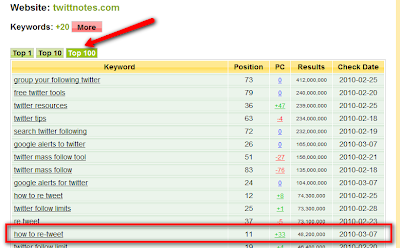
If you noticed, the results show the following information. The keyword (mainly longtail), the position, the PC or position change, the number of results that are returned for that keyword and the check date. There are two clickable items which will yield more information. The first is the keyword. Clicking over a keyword will return all the websites that are ranking for that same keyword. You can then see who your competitors are and do a check on theirs too:), or use this tool’s compare feature (more on that later). That should give you a competitive edge.
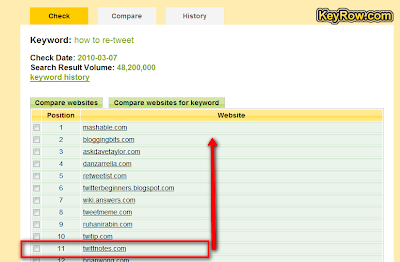
The second clickable item is PC or position change. This shows you how many positions your keyword gained or lost at the time it was last checked (date check). Clicking on the PC item will show a history of dates that had activity on that specific keyword.
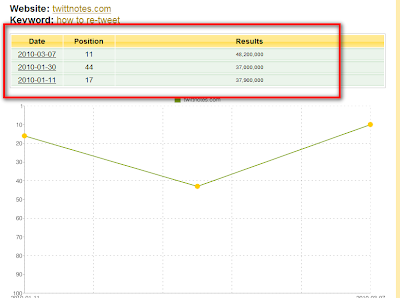
Last but not least, the compare feature. While I was doing this experiment, I noticed that one of twittnotes.com’s competitor is twitip.com of Darren Rowse, for the term How To ReTweet. Curious, I used the compare feature and the results are as follows:
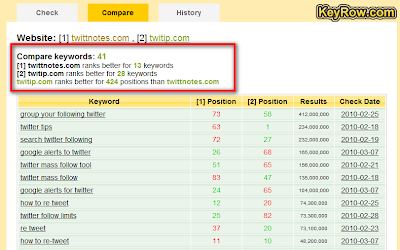
As you can see, I do have at least 13 keywords that rank better than that of Darren, how cool is that, lol. Sorry Darren, better luck next time, haha. Anyway, all of the above are the reasons why I found this simple tool great and somewhat fun to use. How about you, what are your keywords and how do you rank for them on search engines?

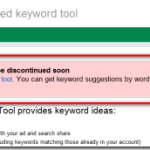







Comments are closed.